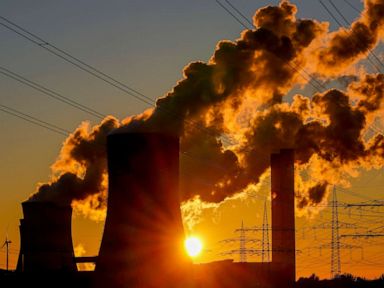
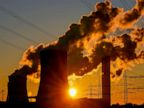

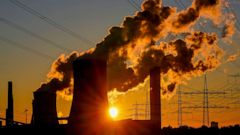
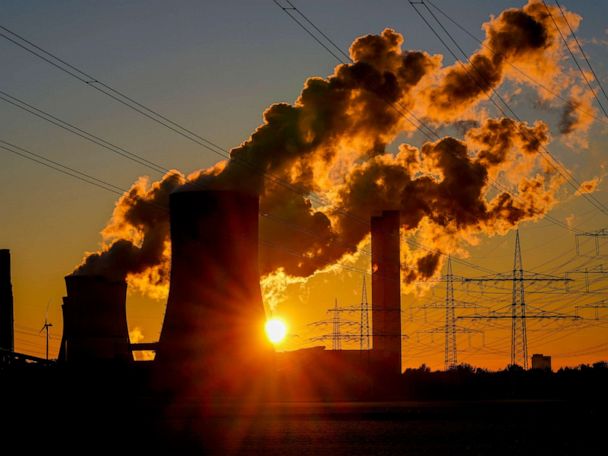
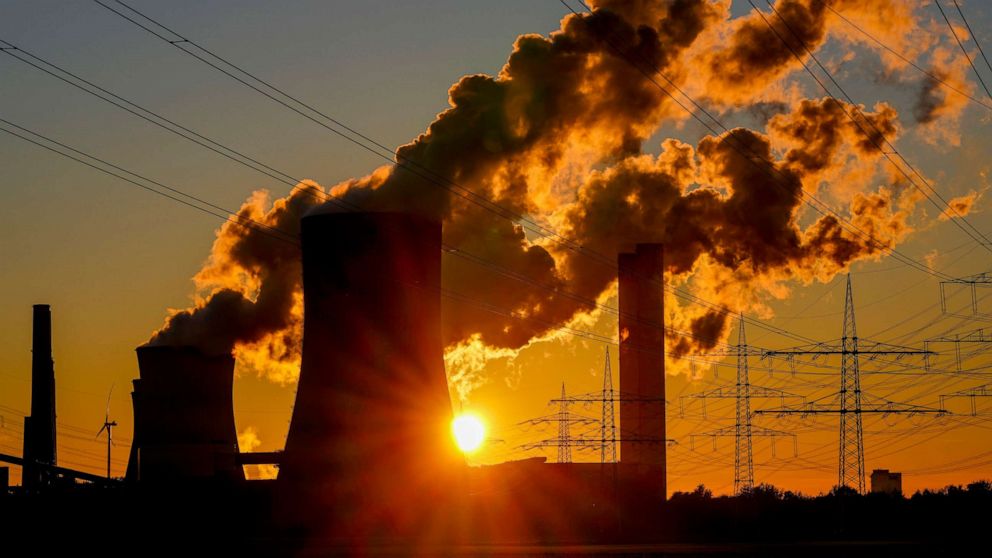
Dubbed a “code red for humanity” by the head of the United Nations, the Intergovernmental Panel on Climate Change said in its most-recent report that the impacts of human-induced climate change are already being seen in “every region across the globe” and urgent action must be taken immediately, not decades into the future, to mitigate the devastation.
As scientists sound the alarms, it has become near-impossible for business leaders to ignore the research — or the global, youth-led protests spurred by activists like Greta Thunberg, who view climate change as an intergenerational justice issue — as a new generation of consumers accuse major greenhouse gas-emitting corporations of robbing the young of their future.
In recent years, a slew of high-profile announcements have followed from hundreds of major U.S. companies, pledging to achieve “net-zero” emissions by a date often decades in the future. Some have welcomed these public-facing commitments as positive indicators that the private sector is heeding to public pressure, but the scientific community says a lack of universal accounting standards results in most of these promises being ineffective, unjust and the latest form of “greenwashing” from corporate America.
Scientists are urging that at this point, with the impacts of climate change already manifesting, the “net” part of these “net-zero” announcements are coming too late and have shifted the focus from reducing emissions to simply “offsetting” them with nature- or tech-based solutions that simply don’t yet exist at the scale necessary to meet the need. Some researchers have used the analogy that if your house is flooding, you would likely focus on turning off the faucet spewing the water rather than on trying to mop the floodwaters up.
“The word ‘net’ is really the key to the zero,” Rahul Tongia, a senior fellow in the Energy Security and Climate Initiative at the Brookings Institution and a senior fellow at the Centre for Social and Economic Progress, told ABC News of these recent pledges from major companies.
“What that means is relying on offsets, where I don’t actually ‘zero’ my emissions, I don’t stop completely, but I compensate for them, I adjust for them, I offset them,” Tongia added. “And this is really a very long, complex challenge of understanding what these mean.”
With businesses and industry contributing to an outsized share of greenhouse gas emissions, it’s going to take more than individual lifestyle changes to tackle the crisis. Here is how scientists say the private sector’s “net-zero” emissions pledges could end up having “net-zero” impact.
Already decades off track to meet climate goals, ‘offset’ commitments don’t cut it
Data directly ties greenhouse gas and carbon dioxide emissions — the largest source of which in the U.S. comes from humans burning fossil fuels for electricity, heat and transportation — to the rising average surface temperature on our planet. This research led to the Paris Climate Agreement in 2015, which sought to limit warming to well below 2 degrees Celsius, preferably to 1.5 degrees, compared to pre-industrial levels by drastically reducing emissions.
In a subsequent report, the Intergovernmental Panel on Climate Change said that the world must bring its carbon dioxide emissions to “net zero” by 2050 in order to keep global warming below the 1.5 degrees Celsius benchmark.
More recent data from the U.N., however, suggests that at the current rate of emissions (if the world continued emitting the same amount of carbon dioxide as it did in the pre-COVID year of 2019), we would surpass our carbon budget necessary to limit warming to 1.5 degrees Celsius in approximately eight years. This means that on our current trajectory, the plans for “net-zero” by 2050 as outlined in the Paris accord likely won’t cut it anymore as the planet could surpass the dire 1.5 degrees Celsius mark around 2030.
A world warmed by just the 1.5 degrees Celsius benchmark would already look vastly different than today, the IPCC has warned, with some 70 to 90% of coral reefs projected to be gone at that temperature (and 99% disappearing at the 2 degrees Celsius mark). Moreover, a warming of just 1.5 degrees Celsius “is not considered ‘safe’ for most nations, communities, ecosystems and sectors and poses significant risks to natural and human systems,” the IPCC has stated, saying some of the worst impacts are expected to be felt among agricultural and coastal-dependent communities.
With the consequences dire, experts say the stakes are too high to rely on vague promises of “net-zero” emissions — with the emphasis on “net” — or offsetting in the future. Over 350 climate-focused nongovernmental organizations recently released a statement directed toward the Biden administration and lawmakers decrying “net-zero” as a “dangerous distraction.”
“Net-zero pledges delay the action that needs to happen,” Diana Ruiz, a senior campaigner at the environmental advocacy group Greenpeace USA, one of the statement’s signatories, told ABC News. “What we’ve seen is more of the abuse of these pledges by corporations to allow them to continue to pollute and and continue business as usual.”
Ultimately, net-zero emissions pledges “can mean a very wide variety of things,” Joeri Rogelj, the director of research at the Grantham Institute and a reader in climate science and policy at the Centre for Environmental Policy at Imperial College London, told ABC News.
“There are lots of net zero targets out there today,” Rogelj added. “What do they mean? It’s not always equally clear.”
In a recent commentary published in the scientific journal Nature, Rogelj and his team of researchers argue that net-zero targets are too vague, and while they are welcome signs of intent, they are fraught with difficulties that impede their effectiveness at reaching climate change goals, and the stakes of climate change are too high to take comfort with mere announcements.
“First of all, a net-zero target can be applied to either carbon dioxide or all greenhouse gases. Very often, that’s not really clearly specified,” he told ABC News, adding the scope of the pledges can also refer to just the tail-end emissions versus the sum of all the activities along the supply chain and distribution of products or services a company delivers.
Greenpeace’s Ruiz, said they ultimately view net-zero pledges as a way for corporations “to greenwash their pollution by using carbon offsets and other false climate solutions.”
“It allows the corporations to continue to pollute while claiming to reduce their emissions somewhere else,” Ruiz told ABC News. “The key here is that net zero doesn’t mean companies will stop polluting.”
Swedish teen activist Thunberg summed up what net-zero pledges mean to her on Twitter as the COP26 conference commenced, writing: “I am pleased to announce that I’ve decided to go net-zero on swear words and bad language. In the event that I should say something inappropriate I pledge to compensate that by saying something nice.”
How a computer model ‘opened Pandora’s box’: Where does ‘net-zero’ come from?
Climate scientist Wolfgang Knorr, a senior researcher at Sweden’s University of Lund, has said he now feels remorse over how some of his earlier climate research, built by computer models, was coopted by policymakers and the private sector to contribute to the rise of net-zero pledges.
“Basically, what happened is the Paris Agreement was signed, but then nobody actually knew what it meant,” he said. “And then the scientific community, the IPCC tasked to actually figure out what 1.5 meant in two ways — what’s the difference between climate impacts with 1.5 versus 2 degrees of warming? And the other question is what needs to be done and/or what can we still emit to stay within 1.5 degrees?”
To solve for the latter, Knorr said he was running integrated assessment computer models that looked at how the economy works and calculating in emissions from industrial activity, the agricultural sector and more to figure out the best pathway to keep the rise in global temperature below 2 degrees Celsius, and preferably within 1.5 degrees Celsius, as outlined in the Paris Agreement.
“Personally, my job was and has been for most of the time to devise mathematical models,” he said, adding that in these models, “the ‘net’ exists as an abstract idea, but what it means in reality, that didn’t actually affect these models at all by the way they were constructed.”
The models they ran, he said, found “it’s just not possible” to keep warming below 1.5 degrees Celsius with all of the other variables, and he wrote in his research that in the end, “any remaining emissions would have to be offset.”
“We actually really wrote, then, by some ‘artificial means,'” he added of offsets, but stressed that this was still “just existing in a computer model and their lines of code.”
“By bringing that offsetting on the table, we have basically opened Pandora’s box,” Knorr says now. “We should have been really cautious about bring it on the table.”
“That ‘zero’ has sort of disappeared from sight, and it’s all about the ‘net,'” he added. “I think that I might have contributed to this.”
In its most-recent 2021 report, the IPCC simply defines “net-zero” as a “condition in which anthropogenic carbon dioxide (CO2) emissions are balanced by anthropogenic CO2 removals over a specified period,” though details on this “removals” process remain sparse.
“Originally, when I was working on this topic like 10 years ago or more, we were thinking about, ‘OK, I mean, maybe a few percent of what we emit, CO2, will have to be offset,’ because for example, cement production is very difficult without producing CO2, or certain forms of agriculture might be still be emitting greenhouse gases.”
“But we were not thinking of entire sectors carrying on, like the fossil fuel sectors, for example,” he said.
Unpacking the ‘offsets’ that ‘net-zero’ pledges are based on
At the core of net-zero emission pledges is the concept of offsetting emissions, but scientists warn that the nature-based proposals are limited and fraught with potential environmental justice issues and the technology-based proposals haven’t nearly caught up with the scale and pace of emissions. The myriad of net-zero pledges are likely betting the planet’s future on the possible development of carbon removal technology emerging at some point.
“The potential for that carbon dioxide removal is very limited,” Rogelj, who has been a lead author for multiple annual Emissions Gap Reports by the United Nations Environment Programme, said. “First of all, because it’s expensive, because we have limited land and because we can’t scale those technologies up quick.”
Rogelj said ultimately, the science shows that rather than offsetting, the focus should be on deep reductions of emissions in the first place. What has emerged, however, is “companies that basically are not focusing on reducing their greenhouse gas emissions, but rather are buying very cheap offset credits, not all of which are very reliable or trustworthy.”
“For a very small cost, they just continue polluting while giving the impression of trying to achieve ‘net-zero,'” he said.
There is no universal standard for offsetting or offsetting credits, Rogelj added, which is why it is important for the public to unpack what a company or even country means when they say their emissions are “net-zero” versus “zero.”
Knorr said there have been offsetting proposals “that basically allow a company or country to emit more than pledged for when another entity does less of that.”
“That’s often called avoidance offsetting, and it’s really important to stress because it’s often not very clear,” he said, arguing that this system needs to be entirely done away with. Among the worst net-zero pledges he’s seen emanating from Eastern Europe simply counted the nation’s existing forest lands as an “offset” that then by their calculations meant they essentially had to take no action on reducing emissions while claiming a goal of “net-zero.”
The second two forms of offsets, according to Knorr, are “nature-based solutions” (like planting trees) and “technological solutions” (that use emerging tech to remove carbon from the atmosphere and often store it underground).
Nature-based solutions often rely on land in poorer or developing nations to make up for the carbon emitted by wealthier countries, Knorr said, adding, “We currently have far too many tree-planting pledges for there being places, and there are also people living in these areas that might actually be then claimed for that.”
Thunberg said in a tweet that these nature-based offsets are also often fraught with human rights and environmental justice issues.
“Nature-based offsetting that relies heavily on land use in the Global South and in Indigenous lands risks shifting responsibility for emissions made by Global North countries to those already struggling with the impacts of the climate crisis and are least responsible for it,” she wrote from COP26.
While technology is rapidly improving in carbon capture and removal techniques, it has been hard for them to keep up with the amount of emissions being spewed.
The world’s biggest carbon capture facility opened in Iceland just last month to much fanfare. According to the calculations posted to Twitter by climate scientist Peter Kalmus, however, “If it works, in one year it will capture three seconds worth of humanity’s CO2 emissions.”
Echoing the questions of fairness raised by Thunberg and others, Tongia said that the impacts of carbon dioxide emissions on the globe are indiscriminate — highlighting the need for wealthier nations and corporations to take actions beyond just exploiting the land or lack of carbon coming from poorer nations.
“It doesn’t matter if a rich person or a poor person emits or cuts down, carbon is a global externality or pollutant,” he said. “So by saying all carbon is equal, that’s what offsets are intellectually driven by, that lets someone richer pay for the offset in a poor country.”
The real, capital-intensive challenges require changing industrial processes and the infrastructure that relies on fossil fuels, according to Tongia, which can take decades before seeing a return on investments.
“Instead of doing all of that, if you have an offset mechanism, the rich are able to say, ‘Oh, I’ll take an offset through low-hanging fruit that happens to be with a developing country,'” he added, such as a forestation project, which is a relatively cheap endeavor. “But that doesn’t actually reduce their emissions, it’s just a zero-sum game at one level.”
“The problem becomes, now let’s say some years later, the poor country needs to reduce its emissions as well, there’s nothing for them to offset against,” Tongia said. “And at that point we’ll be such far along this trajectory of total emissions, that we can’t rely on offsets anymore.”
Ultimately, with the damage already done, Knorr said this “net” or “offset” faze is “quite tangential in the current debate,” admitting that “to a large degree we have failed, also as scientists for example, for not calling that out.”
Looking beyond net-zero pledges
Tongia said that in his research, these offsets seem to have emerged in the private sector as short-term solutions while tackling the climate crisis needs to have a much broader approach.
“What I worry about is we’re taking too simplistic of an approach; we’re ‘financializing’ a lot of this space,” he said. “What these companies want is just tell me how to do it today, I’ll write a check.”
“People are stepping up and saying I’m willing to write a check, but now translating that instrument, that writing-a-check into what action on the ground is needed to actually offset those emissions, that is still not figured out,” he said. “And the problem is everyone looks for quick fixes.”
“It’s not that people are inherently evil,” he added of those looking for offsets. “But in general, it’s that people are looking for things that they’re familiar with, comfortable with, that are visible and achievable. This is a long-haul problem, and so just looking for short-term wins isn’t going to be enough.”
Rogelj and his colleagues established a “checklist” for how consumers can hold leaders accountable with their net-zero plans.
The threefold checklist includes examining the scope, fairness and road map of these plans.
The scope asks what global temperature goal does the plan contribute to, what is the target date for net-zero, which greenhouse gases are considered, what is the extent of the emissions, what are the relative contributions of offsets and how will risks around offsets be managed.
The fairness arm asks what principles are being applied, what the consequences for others are if these principles are applied universally, how will the individual target affect others’ capacity to achieve net zero and more.
“Net-zero targets globally are a zero-sum game,” Rogelj said. “If one country or company reduces emissions more slowly, then another country or company needs to do more for the same global net-zero target to be met. And that is really where this question of adequacy and fairness comes into play.”
“So, based on whether one operates in a sector that has a lot of mitigation potential, that has a lot of carbon dioxide removal potential, that has really large profit margins, it can be considered more or less fair to go slow or on the other hand to go particularly fast on carbon dioxide mitigation,” he said.
Finally, the roadmap asks for milestones and policies, monitoring and review systems to assess progress, and if net zero will be maintained or if it is a step toward net negative.
“Besides net-zero pledges, it is absolutely essential that the private sector sets targets that are measurable over the near term, and targets that really show the trajectory on which a company or a sector is evolving towards a long-term pledge,” Rogelj said. “Setting pledges for three decades in the future, and not working towards them, is simply greenwash.”
Tongia similarly said there needs to be a clearer set of standards among the slew of net-zero pledges that can mean so many different things.
“There’s so many layers at which accounting gets very, very tricky and messy,” Tongia said of emissions and offsets. “So, what we need is far better accounting norms, and then we can figure out, ‘Well, these will get full [offset] credit, these will get partial credit, these will share the credit and these should just be thrown out the window.'”
Tongia also argued that in order to be conducted humanely and fairly, more onus on high emitters to reduce emissions immediately is absolutely necessary.
Knorr said he now recommends a global body dishes out strict “carbon budgets” that limit the total amount of emissions without relying on offsets.
“‘Net-zero’ allows you to reliably at least carry on your business model for quite a long time,” Knorr said. “I don’t want to say that people who come up with these pledges aren’t acting responsibly … but it is very clear that they are buying time, and that kind of rapid reduction immediately right now hasn’t happened.”
“The impact of these pledges being in the future is negative,” Knorr said, equating it to somebody battling addiction who continues to binge a substance now, but promises by a far-off date they will quit. “Everybody knows that doesn’t work.”
He added, “Without honesty and going a bit deeper into ourselves and admitting our dependence on cheap energy … I think there’s a big risk that net-zero pledges will have actually even a perverse incentive to just carry on.”

